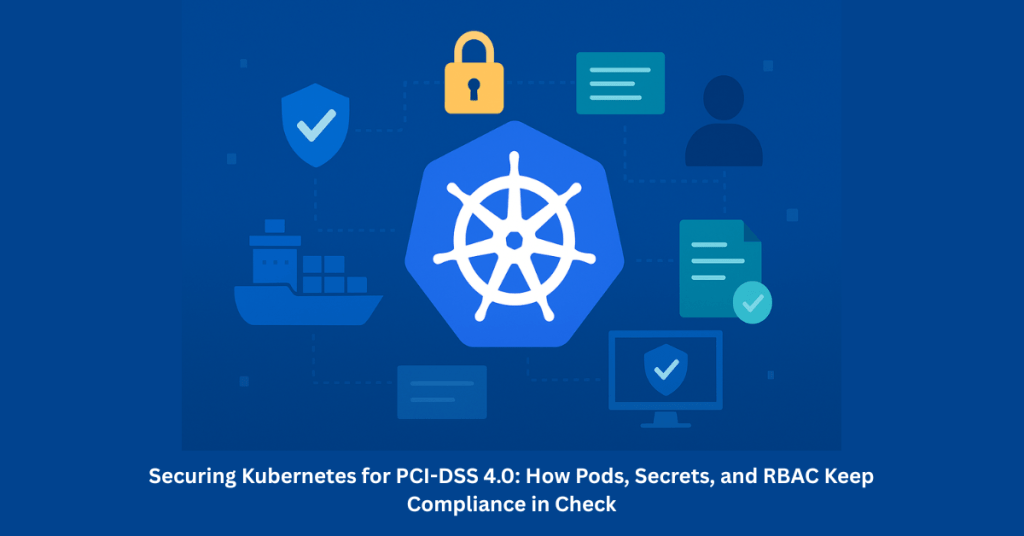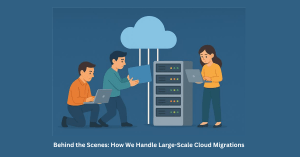For fintechs, payment gateways, and enterprises handling cardholder data, PCI-DSS compliance isn’t optional—it’s mandatory. While Kubernetes provides the flexibility and scalability needed to power modern workloads, compliance requires more than just deploying containers. This article explores how Kubernetes components—Pods, Namespaces, Secrets, and RBAC—map directly to PCI-DSS 4.0 requirements, helping organizations design compliant, secure, and auditable environments.
We’ll also explain how 24x7servermanagement helps businesses achieve PCI-aligned Kubernetes infrastructure with continuous monitoring, isolation, and audit-readiness.
Introduction: Kubernetes Meets PCI-DSS 4.0
PCI-DSS 4.0 (Payment Card Industry Data Security Standard) defines strict controls for organizations that store, process, or transmit cardholder data. It mandates isolation, encryption, access control, and continuous monitoring — all of which align closely with Kubernetes’ architecture.
However, compliance doesn’t come automatically. Misconfigured clusters, weak RBAC rules, or unencrypted secrets can easily lead to audit failures and security incidents.
That’s why understanding how Kubernetes maps to PCI-DSS controls is essential for DevOps and compliance teams alike. Kubernetes can simplify compliance — but only if configured with intention, governance, and the right integrations.
1. Workload and Network Segmentation with Namespaces and NetworkPolicies
PCI-DSS emphasizes network isolation and segmentation to protect cardholder data from unauthorized systems and services.
In Kubernetes, Namespaces provide the logical separation needed for different environments—such as production, staging, and PCI workloads. Each namespace acts like a virtual cluster, isolating workloads to meet the PCI requirement of limiting data scope.
- Example: Your payment microservices handling card data can reside in a “pci-prod” namespace, while marketing or analytics apps live elsewhere.
- Benefit: This isolates sensitive systems, ensuring that only authorized workloads communicate with PCI-related services.
To strengthen segmentation, Kubernetes NetworkPolicies define which Pods can communicate within or across namespaces. This limits lateral movement in case of a breach and aligns with PCI-DSS Requirement 1—installing and maintaining a firewall to protect cardholder data.
Tip: Apply the default deny-all network policy and explicitly allow only necessary Pod-to-Pod communication.
2. Protecting Sensitive Data with Kubernetes Secrets and Encryption
PCI-DSS 4.0 Requirement 3 focuses on the protection of stored cardholder data. While Kubernetes Secrets offer a way to store sensitive information like API keys or database credentials, they aren’t fully PCI-compliant by default.
To meet compliance:
- Enable encryption at rest for Secrets using Kubernetes’ built-in encryption provider.
- Integrate external vaults such as HashiCorp Vault or Azure Key Vault for additional layers of security, audit logging, and centralized key management.
- Rotate secrets automatically using Kubernetes Operators or custom CI/CD integrations.
For example, when Kubernetes Secrets are backed by an external vault with audit trails, encryption, and access versioning, they fulfill key PCI-DSS controls on data protection and key management.
Remember: Never store cardholder data directly in Kubernetes Secrets—only credentials or tokens used to access secure systems that handle such data.
3. Enforcing “Business Need-to-Know” Access with RBAC
PCI-DSS 4.0 mandates that access to systems and data must follow the principle of least privilege—only those who need access to perform a business function should have it.
Kubernetes Role-Based Access Control (RBAC) is the perfect tool for enforcing this.
- Roles and RoleBindings define what users or service accounts can do within a namespace.
- ClusterRoles and ClusterRoleBindings control permissions across the entire cluster.
This structure allows precise alignment with PCI requirements:
- Developers get read-only access to non-PCI namespaces.
- Security or compliance engineers can view but not modify production pods.
- Only system administrators can deploy or delete workloads in PCI-related namespaces.
By designing RBAC roles around job functions and documenting permissions, you can provide auditors with clear evidence that your access control policies meet PCI-DSS Requirement 7.
4. Traceability and Auditability with Kubernetes Audit Logs
Compliance isn’t only about prevention—it’s about visibility.
PCI-DSS 4.0 requires tracking every access, configuration change, and administrative action that impacts cardholder data environments.
Kubernetes Audit Logs record:
- Every API request (who, what, where, when)
- Resource changes (deployments, secrets updates, role assignments)
- Authentication and authorization decisions
These logs serve as verifiable evidence for auditors. However, logs alone are not enough—they must be centralized, retained, and analyzed.
That’s where integration with SIEM systems like ELK, Splunk, or Azure Sentinel becomes critical. Such integrations:
- Provide continuous monitoring and real-time alerts.
- Detect anomalies, privilege escalations, or suspicious activities.
- Help fulfill PCI-DSS Requirement 10, which focuses on monitoring and tracking all access to network resources and data.
Pro tip: Store audit logs securely with access controls and retention policies aligned with PCI’s data retention timelines.
5. The Compliance Trap: Kubernetes Isn’t Automatically PCI-Ready
A common misconception is that using Kubernetes in the cloud makes you “compliant by default.” Unfortunately, that’s far from true.
Cloud platforms like AWS, Azure, or GCP provide shared responsibility—they secure the infrastructure, but you must secure the configuration.
Misconfigured RBAC, overly permissive network rules, unencrypted secrets, or missing audit logs are all common PCI audit failures.
Achieving compliance means hardening your Kubernetes cluster:
- Enforce security contexts and Pod policies (no privileged containers).
- Use Admission Controllers to validate security rules before deployment.
- Regularly scan container images for vulnerabilities.
- Automate compliance checks using tools like Kubescape, Kyverno, or Open Policy Agent (OPA).
Kubernetes gives you the building blocks for compliance — but it’s your configuration that determines if you’ll pass the audit.
6. How 24x7servermanagement Helps You Stay PCI-Compliant
At 24x7servermanagement, we bridge the gap between DevOps engineering and compliance readiness. We help organizations turn complex Kubernetes environments into audit-ready, secure, and continuously monitored systems.
Here’s how we make compliance achievable and sustainable:
a. Translating Kubernetes into PCI-DSS Evidence
Our experts map your Kubernetes setup directly to PCI-DSS controls—so auditors can clearly see how each configuration enforces compliance. We prepare compliance-ready documentation and visual maps for clear audit traceability.
b. Designing Secure, Segmented Clusters
We architect clusters with namespace isolation, strict network policies, and hardened node configurations that align with PCI-DSS’s segmentation and firewall requirements.
c. Hardened Secrets and Encryption
We configure Kubernetes Secrets with encryption-at-rest and external vault integration, ensuring your credentials meet PCI encryption and key management mandates.
d. Enforcing RBAC and Access Governance
We implement granular RBAC policies that enforce the “business need-to-know” principle and maintain audit-ready access logs for verification.
e. Continuous Monitoring and Reporting
We integrate Kubernetes Audit Logs with SIEM or ELK stacks to deliver continuous visibility, alerting, and PCI-aligned reporting. You get monthly compliance summaries and anomaly insights.
f. 24×7 Managed Compliance Support
Our team provides round-the-clock monitoring, patching, and compliance maintenance—so your Kubernetes infrastructure stays secure and audit-ready at all times.
Conclusion: Compliance Through Configuration
Achieving PCI-DSS compliance in Kubernetes isn’t about deploying a few YAML files—it’s about engineering trust, traceability, and security into every layer of your cluster.
When Namespaces, Secrets, and RBAC are configured with compliance intent, they collectively create a strong foundation for a secure cardholder data environment. But to maintain that compliance continuously, you need expert oversight, monitoring, and ongoing governance.
That’s where 24x7servermanagement helps you go beyond “secure” — to verified, monitored, and compliant Kubernetes environments, ready for any audit, anytime.
Frequently Asked Questions
No. Kubernetes itself is not PCI-DSS compliant by default. While it provides features like RBAC, Secrets, and Namespaces that support compliance, organizations must configure them properly. Compliance depends on how securely your clusters, workloads, and access policies are designed and managed—not just on the platform itself. Namespaces and NetworkPolicies enable logical and network segmentation, which aligns with PCI-DSS Requirement 1 on isolating cardholder data environments. Namespaces separate workloads (e.g., PCI vs. non-PCI), while NetworkPolicies restrict traffic flow, preventing unauthorized access and lateral movement. Kubernetes Role-Based Access Control (RBAC) enforces the principle of least privilege—a key PCI-DSS control. It ensures users and service accounts only have the access they need for their specific job roles, reducing the risk of unauthorized data exposure or changes in sensitive environments. 24x7servermanagement helps design, monitor, and maintain PCI-aligned Kubernetes clusters through: Namespace and network segmentation Secrets encryption and vault integration RBAC configuration and audit logging Continuous compliance monitoring and monthly reporting This ensures your Kubernetes infrastructure remains secure, auditable, and always ready for PCI-DSS inspections.1. Is Kubernetes PCI-DSS compliant by default?
2. How do Kubernetes Namespaces and NetworkPolicies help with PCI-DSS compliance?
3. What role does RBAC play in PCI-DSS compliance?
4. How can 24x7servermanagement help achieve PCI-ready Kubernetes environments?






